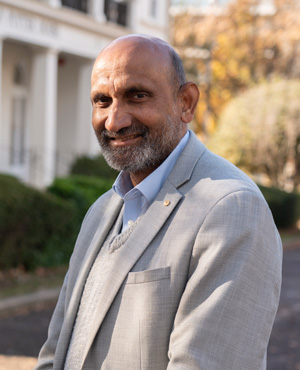
This month the Academy, Australia and science took the global stage at the UN General Assembly (UNGA) in New York. The Academy, in collaboration with Burnet Institute, Brown University School of Public Health, and The OSLUV Project convened more than 300 people from 26 countries at a UNGA High-Level Side Event to galvanise global action to achieve clean indoor air.
Experts, including Academy Fellow Professor Lidia Morawska FAA, joined the global community in signing a pledge to declare clean indoor air a fundamental human right for protecting health and well-being. They were joined by Academy Chief Executive Anna-Maria Arabia OAM, and Burnet Institute special adviser Professor Bronwyn King AO.
I thank the governments of France and Montenegro for co-sponsoring the event. Find out more about the pledge.
Whilst in the United States, Academy Fellows residing in the US, science sector representatives and Academy staff were hosted by the Australian Embassy to discuss the reorientation of the global R&D sector and the Academy’s Global Talent Attraction Program.
We thank Australian Ambassador to the US, H.E. The Hon Dr Kevin Rudd and our collaborators from the Department of Home Affairs for their leadership and support.
Closer to home, we were joined by over 600 attendees from 26 countries, including over 100 early and mid-career researchers, for our flagship event: Science at the Shine Dome.
We watched as our new Fellows added their signatures to the Charter Book, heard from Academy award winners and launched an expanded Asia-Pacific Academic Mentoring Program – all part of the Academy’s role in promoting scientific excellence and strengthening science in Australia and internationally.
Thank you to everyone who joined us at this event, both in person and online. If you missed it, you can read the highlights or watch it online.
Our National Symposium immediately followed Science at the Shine Dome, where the Academy launched Australian Science, Australia's Future: Science 2035, a comprehensive assessment that reveals critical workforce, infrastructure and coordination gaps that threaten Australia’s capacity to meet future challenges.
Led by Academy Fellow Professor Ian Chubb AC and Academy Head of Science Policy and Advice Dr Hayley Teasdale, the report provides a clear roadmap for safeguarding our nation’s innovation capabilities and offers policymakers an evidence-based guide for decision-making about science and education investment, immigration policy and research funding priorities. The data shows there is no room for continued inaction, and this is a message the Academy will continue to prosecute with urgency.
In concerning news this month, the National Climate Risk Assessment reminds us of the need to accelerate action to reduce emissions. Unfortunately, the Australian Government’s revised emission target – while in the right direction – is insufficient. The Academy’s own independent scientific advice to the Climate Change Authority is that we must aim for an emissions reduction target of 74% below 2005 levels by 2030, with net-zero emissions reached by 2035. We acknowledge this is hard to reach but when faced with a challenge, the answer can’t be to lower our ambitions. New solutions will emerge from research – from the creativity and drive of our scientists, if we invest in them. Yet, in Australia the proportion of R&D invested in energy transition is low. The Academy has renewed its calls for accelerated development of novel greenhouse gas removal and storage technologies, which you can read about here.
Earlier this month, the Academy welcomed Minister for Science Senator the Hon Tim Ayres’ decision to begin exploratory talks with the European Commission on Australia’s association with Horizon Europe, the world’s largest research fund. This is a welcomed step toward strengthening our international research partnerships and offers great opportunity for the advancement of Australian science.
I offer my congratulations to PhD candidate Mabel Day from the University of Adelaide on her victory at the finale of Falling Walls Lab Australia. Mabel will be joined by Dr Auriane Drack and Khoi Nguyen at the global finale in Berlin this November together with 97 other young innovators, finalists in their respective Falling Walls Labs held across the world.
Finally, my congratulations to four Fellows, and their research teams, who have been recognised for excellence in research and innovation at the 2025 Australian Museum Eureka Prizes: Professor Arthur Georges FAA, Professor David Komander FAA FRS, Professor Thomas Maschmeyer AO FAA FTSE and Professor Ian Paulsen FAA.
It has been a big month for science and I am proud of the Academy’s multiple contributions locally and abroad over this period. I encourage you to keep reading about celebrations, achievements and other significant activities in this September edition of the newsletter.
Professor Chennupati Jagadish AC PresAA FRS FREng FTSE
President, Australian Academy of Science
© 2025 Australian Academy of Science